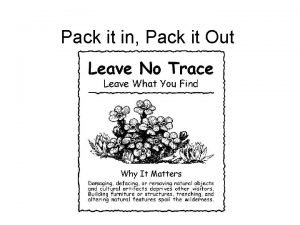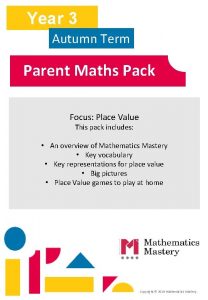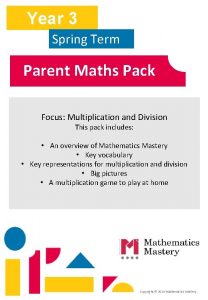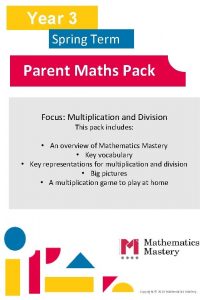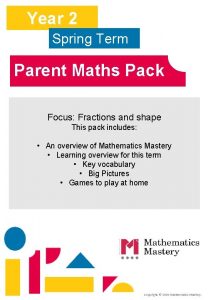Year 2 Autumn Term Parent Maths Pack Focus






- Slides: 6

Year 2 Autumn Term Parent Maths Pack Focus: Addition and Subtraction This pack includes: • An overview of Mathematics Mastery • Key vocabulary • Key representations for addition and subtraction • Big Pictures • Addition and subtraction games to play at home Copyright © 2019 Mathematics Mastery.

Mathematics Mastery What is ‘Mastery’? The ‘mastery approach’ to teaching mathematics is the underlying principle of Mathematics Mastery. Instead of learning mathematical procedures by rote, we want your child to build a deep understanding of concepts which will enable them to apply their learning in different situations. To achieve this we aim to develop pupils’ Conceptual Understanding, Mathematical Thinking and Language and Communication. (See diagram below) Representing concepts using objects, pictures, words and symbols; making connections Making conjectures, trying out specific examples, organising, comparing, looking for patterns and generalising Conceptual understanding Mathematical problem solving Mathematical thinking Explaining, justifying and discussing using accurate mathematical language Language & communication Central to learning mathematics Success for all At school we believe all pupils can achieve success in maths. We encourage pupils to have a ‘growth mindset’ – a belief that effort leads to success and that challenges are opportunities to learn. Here a few tips to encourage your children at home with maths: ü ü ü Talk to your children about everyday maths Play games with them Value mistakes as learning opportunities Recognise that there is more than one way to work things out. Praise children for effort over outcome. Avoid saying things like “I’m useless at maths”. Copyright © 2019 Mathematics Mastery.

Autumn focus: Addition and Subtraction Year 2 - Autumn Curriculum Map Numbers within 100 Addition and subtraction of 2 digit numbers Addition/ Subtraction problems Measures: Length • Read, write, • Apply number • Introduction represent, partition, compare and order numbers to 100 • Explore patterns including, odds and evens, tens and ones bonds to ass and subtract • Represent and explain addition and subtraction of two 2 digit numbers • Add three 1 -digit numbers to bar models as a representatio n • Crate, label and sketch bar models. Graphs Multiplication and division: 2, 5, 10 • Draw and • Represent • Calculate the times measure lengths in centimetres • Use <, > and = to compare and order lengths in m and cm and interpret: pictograms, block diagrams, tables and tally charts. tables of 2, 5, and 10 by skip counting • Relate the 2 times table to doubling • Explore representations • Commutativity This term one of our key focuses in Year 2 is addition and subtraction within 100. Below are some of the key small steps pupils will be learning about: 1. 2. 3. 4. Using number bonds in addition and subtraction Adding and subtracting ones with a twodigit number Adding and subtracting multiples of ten Adding and subtracting tens with a two digit numbers 5. 6. 7. 8. Adding and subtracting two 2 -digit number Adding three 1 digit numbers Representing information in a bar model Representing addition and subtraction word problems as a bar model. Key vocabulary for Year 2 - addition and subtraction Part Add/Addition Whole Ones: Tens: Subtract/Subtraction Is equal to (=) If I know…then I know What is known? What is unknown? Equation: a mathematical statement where two values are equal indicated by the = sign. E. g. 12 + 4 = 16 is an equation. Number bonds: pairs of numbers that add together to make a different number. E. g. one number bond to 8 is 3 and 5. Partition: to split a number into two or more parts e. g. we can partition 16 into 10 and 6. Introducing the bar model In Year 2 pupils continue to use the partwhole model and begin to use the bar model to interpret problems. This supports pupils in understanding the mathematical structure of the problems they are solving. The language of parts and whole continue to be used. “The parts are 16 and 11, the whole is 24. ” 16 27 27 16 11 Copyright © 2019 Mathematics Mastery. 11 11

Big Pictures What maths can you see? Discuss with your children at home using the key vocabulary from the previous page. Copyright © 2019 Mathematics Mastery.

Try this at home – workshop games Make 100 For this game, you need dice, a pencil and paper. Each player draws an addition grid like this: Take it in turns to roll the dice. After you have rolled the dice, you decide which box to place that number in. Once all four numbers have been placed, add your two 2 -digit numbers to get your total. Closest to 100 wins. Adapting: You can change the target total, or try using subtraction. ones tens add subtract is equal to If I know…then I know… Zero the hero 4 0 3 1 6 3 2 2 7 1 7 5 6 4 5 8 ones tens add For this game you need the number grid, (or make your own filled with numbers under 10) two cubes/counters, a plastic cup and pencil and paper. Write 50 down as your starting score. Put two cubes into the plastic cup and roll them onto the grid. Add the two numbers together then subtract from 50. Take it in turns to do this. The first to reach zero is the winner. subtract is equal to If I know…then I know… Copyright © 2019 Mathematics Mastery.

Try this at home – more ideas Daily practice: number bonds Challenge your children with missing number problems verbally. Example “The whole is 9. One part is 3. What is the missing part? ” Or “I think of a number, I subtract 3 and I am left with 6, what was my number? ” 3 ? 19 3 16 ? Dice games Playing with dice can be a great way to support your children with number bonds. If you don’t have a pair of dice, try these online dice: https: //www. random. org/dice/? num=2 Fact of the day/week Have a ‘fact of the day’, e. g. 15 = 7 + 8. Pin this fact up around the house. Practise reading it in a quiet, loud, or squeaky voice. Ask your child over the day if they can recall the fact. Board games, sports and leisure Board games and sports provide lots of opportunities to develop mathematical skills such as problem solving and strategy. Additionally lots of board games and sports also allow opportunities for addition and subtraction when totalling scores or finding the difference. When playing, ask questions such as: • “How may points do Amy and Mina have altogether? ” • “What’s the difference between my score and yours? “ • “How much more does Charlie have compared to Ahmed? ” • “How many more do I need to win? ” Money, money Allow children to have experience handling money. Some experiences could include: • Counting amounts • Regrouping – e. g. exchange ten 10 ps for 1 pound • Finding a change • Discussing prices in the supermarket and involving your children when paying • Saving up pocket money for something. “How much more do you need? ” Questions to support thinking • What do you think would happen if…. • • What’s the same? What’s different? • • How do you know that? Can you see a pattern? What would come next? What else could go in this set? What couldn’t? Copyright © 2019 Mathematics Mastery.
